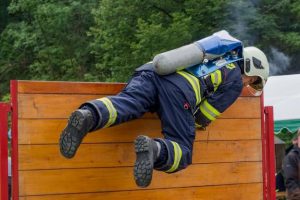The SportBeeper: Revolution in Firefighter
Tests In the field of firefighters, physical fitness is essential. Physical fitness testing is not only a requirement for entering the ranks of the fire service, but it is also crucial for maintaining optimal fitness levels throughout one’s career. The introduction of the SportBeeper has brought a new era in firefighter fitness assessment, providing a more accurate, objective and effective approach to measuring physical performance.
1.What is SportBeeper?
The SportBeeper is an electronic device for measuring physical performance, also designed for physical fitness tests for firefighters. It uses a combination of advanced sensors to track and record various metrics, such as speed, endurance, during physical tests. This tool frees the coach from timing and whistle blowing so that he can devote himself entirely to running his session without losing sight of his athletes. But also to ensure the sequential and sound control of exercises or tests. By being thus freed from timing and whistle blowing, the coach can devote himself entirely to running his session, providing possible corrections or technical information. It is an intuitive, simple, effective tool with quick configuration of exercises and tests. A particularly appreciated new feature: the Tab-odometer which calculates and displays the distances to be covered for each racing sequence according to the chosen speed, making it easy to set up the cones.
2.Operation and Use
During firefighters’ fitness tests, the SportBeeper records data relating to the participant’s physical performance in real time, such as running speed, number of repetitions in a certain period of time, or distance covered.
3.Benefits of SportBeeper in Firefighter
Tests Objectivity and Accuracy: Unlike subjective assessments, the SportBeeper provides objective data on participants’ physical performance, eliminating potential bias in the assessment. Comprehensive Assessment: The device is capable of measuring a wide range of physical metrics, allowing a comprehensive assessment of firefighters’ fitness, from speed to endurance. Progress Tracking: By recording performance over time, the SportBeeper allows precise monitoring of participants’ individual progress, thereby motivating firefighters to continually improve their physical condition.
4 The tests present in the sportbeeper
- VMA test
- VAM-EVAL test
- Conconi test
- Probost test
- Cooper 12′ test
- Continuous open testing
- Intermittent test Test
- Piste U. Montreal
- 45-15 5 FIT TUB 2 departure..
A multitude of tests to carry out
5.Impact on Recruitment and Training
The introduction of the Sportbeeper into firefighter fitness testing has had a significant impact on recruitment and training. As an objective and accurate tool, it ensures that only candidates capable of meeting the rigorous physical requirements are selected, thereby ensuring the safety and efficiency of fire crews. Additionally, by providing accurate data on individual performance, the SportBeeper allows training instructors to design personalized training programs, thereby optimizing firefighters’ physical preparation for field challenges.
Conclusion
The SportBeeper, thanks to its innovative capabilities, marks a significant advance in the assessment of the physical condition of firefighters. By collecting objective and precise data on the physical performance of firefighters, this device allows a more in-depth and reliable assessment of their physical fitness level. This information is crucial to ensuring firefighters are prepared to meet the physically demanding challenges encountered in the field during emergency responses.
By providing tangible, measurable data, the SportBeeper helps improve several key aspects of fire and rescue services. First of all, it plays an essential role in the recruitment process, allowing recruiters to objectively assess the physical condition of candidates and select the individuals best suited to the demanding profession of firefighting. Additionally, the SportBeeper proves to be a valuable tool for firefighter training. By identifying areas of weakness and tracking progress over time, it allows instructors to design personalized and effective training programs, aimed at improving firefighters’ physical performance and building their resilience in the field.


